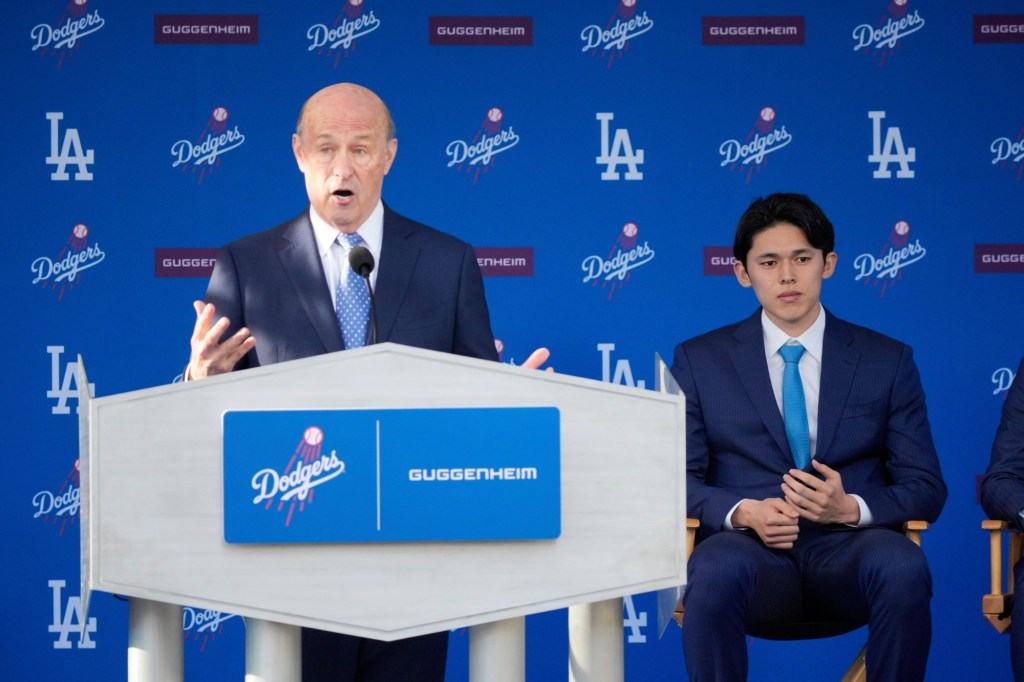
Flush with success last winter, the Dodgers sought out ways to make themselves a destination franchise for the best players they could find.
Deferred salaries were one thing. But they also saw it as a duty to find a No. 2.
And that’s how the newly-renovated home clubhouse – manager’s office included – at Dodger Stadium came to include eight sophisticated, state-of-the-art, multi-function, heated-seat, bidet-equipped Japanese-style toilets.
They can thank Roki Sasaki for giving the defending World Series champions their new thrones.
“During our first meeting with Roki, we were telling him about the project we had ongoing to upgrade our clubhouse and facilities,” team president and CEO Stan Kasten related, referring to the $100 million renovation project that left Dodger Stadium partially stripped down for much of the winter – especially in early December when the highly-sought after Sasaki was weighing his options as a free agent and visiting potential baseball homes.
“I was telling him about all the amenities we were adding. ‘We’re going to have this and this and this.’ And he asked, ‘Are you going to have Japanese-style toilets?’”
Never one to let a potential negotiating advantage get away, Kasten asked Sasaki if putting in his preferred style of toilet would help Sasaki decide where he would sign.
Asked about it now, Sasaki said he was just joking with Kasten – but not really.
“It sounds like a joke. But for me, it’s pretty important,” Sasaki said through an interpreter.
The Dodgers’ willingness to make changes for players’ comfort “was definitely a factor” as he was thinking through where to start his MLB career.
“Done. You got it,” Kasten said he told Sasaki at that initial meeting. “It was a good idea that we got from a player.”
It was a good idea he had to take to Janet Marie Smith, the Dodgers’ executive vice president for planning and development. During her 30-plus years in MLB, Smith has had her hands in designing Baltimore’s Camden Yards, transforming Olympic Stadium into the Braves’ Turner Field home, renovating Fenway Park (including the unique Green Monster seats) and updating Dodger Stadium in multiple ways over the past 13 years.
But it wasn’t going to be easy. The clubhouse project was well underway. In fact, Smith said, workers had just poured concrete days before Kasten made his promise to Sasaki.
“The concrete wasn’t even wet around it yet,” she said.
Kasten took the request to Smith anyway.
“Do you think that’s the first time Stan has done that to her?” said Kasten, who has worked with Smith in Atlanta and Los Angeles. “Her reaction was, ‘But, Stan – this. But this. But this.’ I just said, “Yeah, I know. Can we do it?’ ‘Well, yeah.’ ‘Then let’s do it.’
“If it sent a message to our players about being responsive then it was worth it.”
Kasten acknowledged “it took some doing” and he won’t discuss how much expense it might have added to the $100 million project (a number he also won’t confirm).
It actually took some undoing. The Dodgers could have re-hired former pitcher Kevin Brown for the project. The bathroom had to be torn apart – and not just a little. It was not a simple one-for-one replacement. The new toilets required different plumbing as well as wiring for power.
But Smith agreed it was worth it.
“We have so many players from different cultural backgrounds and different standards for hygiene and privacy,” she said. “If we have the means to make them more comfortable, we should do it.”
The Dodgers’ trips to South Korea and Japan the past two years had also opened eyes in the Dodgers’ traveling party to what those standards look like in practice.
“I really enjoyed the chance to go to Tokyo for a lot of reasons,” Smith said. “But part of it is we learned that what we consider high-end toilets are so ubiquitous there that the only place we saw so-called ‘normal’ toilets was in public parks – and they were labeled ‘Western-style’ toilets and had instructions.”
When the Dodgers returned from that trip to Tokyo in March, the clubhouse renovation was complete. The toilets were just one of many luxury touches.
“Yeah, everyone did (notice the upgrade). It’s nice. It’s very nice. Those are kind of the standard toilets in Japan so it kind of felt like we hadn’t really left,” Dodgers third baseman Max Muncy said, acknowledging he has taken a hands-off approach to the control panel – described by Smith as looking like an airplane cockpit.
“I don’t know how to use them,” Muncy said. “I don’t know what does what. I don’t want to mess with it.”
Kasten couldn’t wait to tell Sasaki about the team’s new additions after the young right-hander signed with the Dodgers.
“I took great pleasure in telling him the next time I saw him that they were going in,” Kasten said. “I got a big laugh. I think I showed him pictures. He said, in English, ‘Awesome.’
“He has learned the word, ‘Awesome.’”
Sasaki has also learned about irony. When the team was in Washington earlier this month, he pointed out to Kasten that the visitor’s clubhouse at Nationals Park lagged behind in toilet technology.
“I had to admit that I was the one who built that stadium,” said Kasten, the Nationals team president while Nationals Park was constructed.
Sasaki said he was surprised the Dodgers had followed through on Kasten’s promise because “none of the other ballparks have them.” He also pointed out the team has “a lot of Japanese staff” who appreciate the change.
But the lid doesn’t close there.
“Everything about the new clubhouse is first class,” Dodgers reliever Evan Phillips said. “So it only makes sense that would apply to the bottom line, too.”
UP NEXT
Pirates (RHP Paul Skenes, 2-2, 2.87 ERA) at Dodgers (RHP Yoshinobu Yamamoto, 3-1, 0.93 ERA), Friday, 7:10 p.m., SportsNet LA, MLB Network (out of market), 570 AM
Originally Published:



